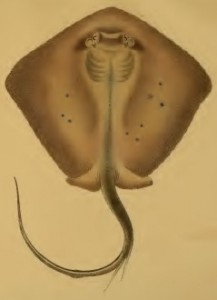Feeding habits of Ningaloo stingrays in the spotlight
News Release
Murdoch University
06. May 2013
———————
 A new study has shed light on the diets and feeding habits of Ningaloo’s stingrays, information which has never been documented before.
A new study has shed light on the diets and feeding habits of Ningaloo’s stingrays, information which has never been documented before.
“As meso-predators, stingrays are an important link between the top and bottom of the food chain,” said Dr Owen O’Shea, of Murdoch University and the Australian Institute of Marine Science.
“They are ‘engineers of the sea’, changing and creating habitats as they feed. When looking for food, rays churn up the sediment on the ocean floor, which is very important, both physically and at a chemical level.
“The physical act of disturbing the sediment resuspends nutrients, but also allows other creatures to access hidden prey, which they previously couldn’t reach.
“As consumers themselves, they can give us an insight into the role stingrays play in coastal ecosystems, and highlight their importance as a key-stone group of fishes.”
During the study, Dr O’Shea and his team analysed the stomach and gut contents of 170 rays across 18 different Ningaloo Reef locations.
With five species of stingray sharing the same habitat, researchers expected to find that different species would feed upon different prey to reduce competition and ensure there are enough resources to go around. But the findings proved that this wasn’t necessarily the case.
“Only one species showed evidence of a different diet, which is interesting given the abundance of rays in these coastal ecosystems. We thought it would be more,” he said.
“Four of the five species we examined had overlapping diets consisting mainly of marine worms. This suggests that the area supports a biologically rich community with an ample supply of food, so the need to share resources was not apparent.”
Described as the ‘underdogs’ of the marine world, Dr O’Shea said stingrays were threatened by many of the same challenges which threatened sharks, but that conservation efforts and scientific literature tended to overlook them in favour of their marine cousins.
Dr O’Shea hopes his research, which has just been published in the Journal of Fish Biology, will shine the spotlight on the importance of rays as possible indicators of ecosystem health. He hopes this will allow decision-makers to consider the impact any coastal development will have on ray populations and the functions they perform.
Having completed his PhD at Murdoch University, Dr O’Shea will continue his work with sharks and rays, recently accepting a position as a Shark Research Associate at the Cape Eleuthera Research Institute in the Bahamas.
Source: Murdoch University
Related Scientific Paper :
O’Shea, O. R., Thums, M., van Keulen, M., Kempster, R. M. and Meekan, M. G. (2013),
Dietary partitioning by five sympatric species of stingray (Dasyatidae) on coral reefs.
Journal of Fish Biology. doi: 10.1111/jfb.12104
—————————-
